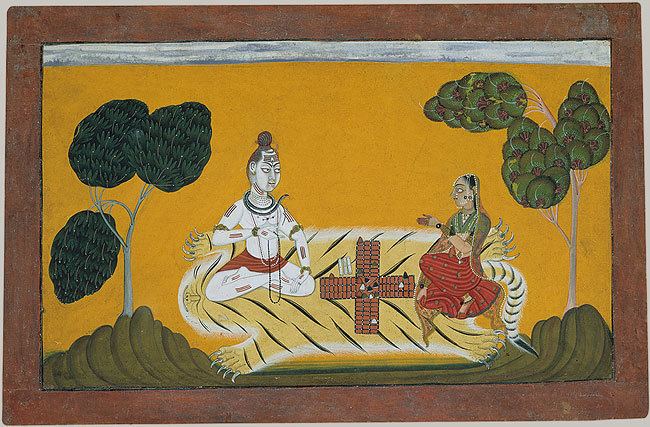Chaupar is a cross and circle board game very similar to pachisi, played in India. It is believed that both games were created around the 4th century. The board is made of wool or cloth, with wooden pawns and six cowry shells to be used to determine each player's move, although others distinguish chaupur from pachisi by the use of 3 tetrahedral (four sided) long dice. The game is usually played on a table or the floor.
This game is usually played in a bantering manner, and it is quite common for players to mock each other's play just before the chori's are thrown, or to attempt to distract their opponent by snorting, cracking knuckles, pretending to spit or making absurd noises to "curse" or spoil the opponent's turn.
If any of the players does not have his "thore" (to have killed at least one pawn) by the end of the game, then that player is known to have lost with a "bay-thoree" which is the most disgraceful form of losing.
There are famous stories amongst Mughals past from generation to generation about kings who played this magnificent game. One particular tale tells of a King who had 2 trained mice called "Sundhree and Mundhreee". This king would distract his opponent with details stories and tales. He would then casually pronounce "Sundhree and Mundhree"; at this point the mice would come and move the pieces around without the opponent noticing.
Games can last anything from 30 mins to hours and hours. Technically, a game can never end depending on the players. This is possible if players keep doing "Alkhee" ghaats.An extra turn is granted by playing a 6, 12, 10 or "8" (25 square move).There are 8 safe squares (called Cheere).The pawns do not get out from the Charkoni (nest) square, but from the 10 or "8" (25 square move)The cowry shells can be used to play a variety of moves. for example if they all face down = 6, 1 face up = 10 (one bonus square move or awaken a new pawn), 2 face up = 2, 3 face up = 3, 4 face up = 4, 5 face up = "8" (25 square move with one bonus square or awaken new pawn), 6 face up = 12.Forfeiting the turn voluntarily is not allowed (unlike Pachisi).the game is either played by 2 opponents who sit opposite each other with 4 pawns each. or is played by 2 partners Vs 2 partners. The partners sit opposite each other. If either partner gets all his pawns up, then that partner will miss his/her turn for 5 times and then will aid his partner thereafter. For example, if Partner A is using red pawns and Partner B is using yellow pawns. If partner B gets all his pawns up and misses 5 turns. This means that every turn that Partner A AND B play will be used to move the red pawns.When a pawn reaches the 'top'; that pawn can be removed by the top voluntarily by playing a 10 or an "8". This "re-awakened" (called an "Alkhee") pawn can kill other pawns who have partnered up together on the same square or pawns on a safe square and can be awakened from any of the 4 houses. It will go up to the house from which it was awakened.Players cannot move their pawns past the safe square outside their house (to go into their house) unless they have killed at least one pawn. To gain their "thore".It is not allowed to fix the cowri shells before throwing them. This is cheating and is known as "Bandhana".The cowri shells are usually thrown in 3 styles: either by sliding them, throwing them in the air with one cowri placed on the index finger (which is thrown higher) or by spinning them in the hand.
